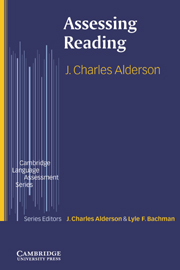Book contents
- Frontmatter
- Contents
- Series Editor's Preface
- Acknowledgements
- Abbreviations
- 1 The nature of reading
- 2 Variables that affect the nature of reading
- 3 Research into the assessment of reading
- 4 The reader: defining the construct of reading ability
- 5 A framework for test design
- 6 Tests in the real world: test purposes
- 7 Techniques for testing reading
- 8 The development of reading ability
- 9 The way forward. Assessing the interation between reader and text: processes and strategies
- Bibliography
- Index
4 - The reader: defining the construct of reading ability
Published online by Cambridge University Press: 03 May 2010
- Frontmatter
- Contents
- Series Editor's Preface
- Acknowledgements
- Abbreviations
- 1 The nature of reading
- 2 Variables that affect the nature of reading
- 3 Research into the assessment of reading
- 4 The reader: defining the construct of reading ability
- 5 A framework for test design
- 6 Tests in the real world: test purposes
- 7 Techniques for testing reading
- 8 The development of reading ability
- 9 The way forward. Assessing the interation between reader and text: processes and strategies
- Bibliography
- Index
Summary
Introduction
In the past three chapters I have reviewed a considerable amount of research into and theories about the nature of reading and the assessment of reading. I have also commented at the end of each chapter on the relevance of findings or opinions for testing and assessment procedures. I now need to pull the various threads together and discuss issues of test design and the relationship between theories of reading, reading in the real world and the assessment of reading.
At this point in the book, the reader is likely to feel somewhat over–whelmed, both by the mass of detail that emerges from any survey of theory or research into reading, and by the lack of an organising framework. True, I have presented a three–fold organising principle: of reader, text and interaction, but this is itself rather too broad for the purposes of test design. After all, in tests the focus is necessarily on the reader—their ability to read—since that is what we try to measure, to infer from test performance.
In this chapter I shall discuss test constructs and constructs of reading, and I shall illustrate how they have been operationalised. In Chapter 5 I shall consider the relationship between test tasks and real–world reading at some length. This will be partly in order to bring into a coherent and fairly comprehensive framework those aspects of reading that have been shown to be of importance for an understanding of the construct.
- Type
- Chapter
- Information
- Assessing Reading , pp. 116 - 137Publisher: Cambridge University PressPrint publication year: 2000



